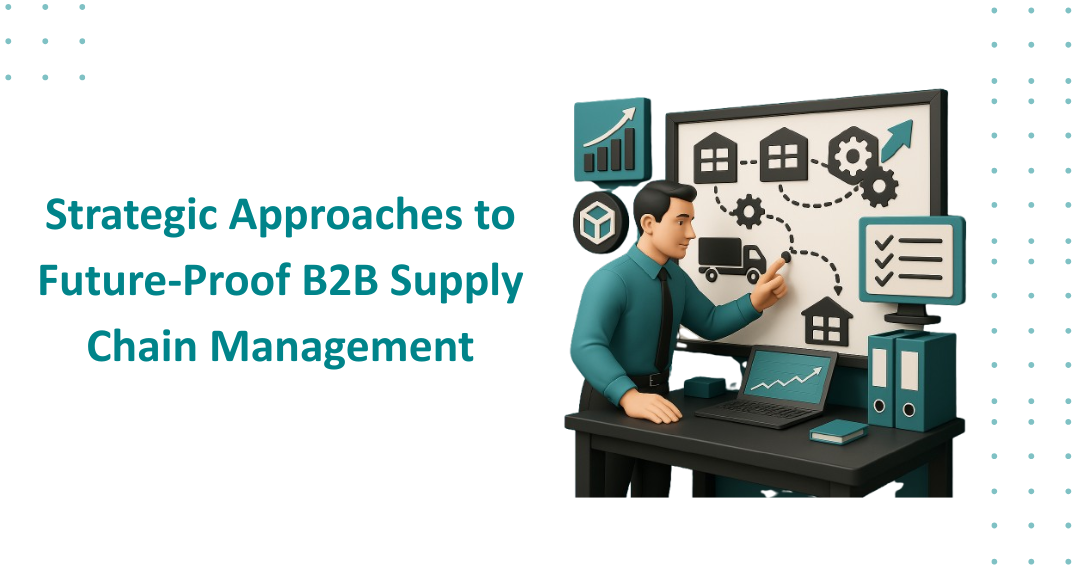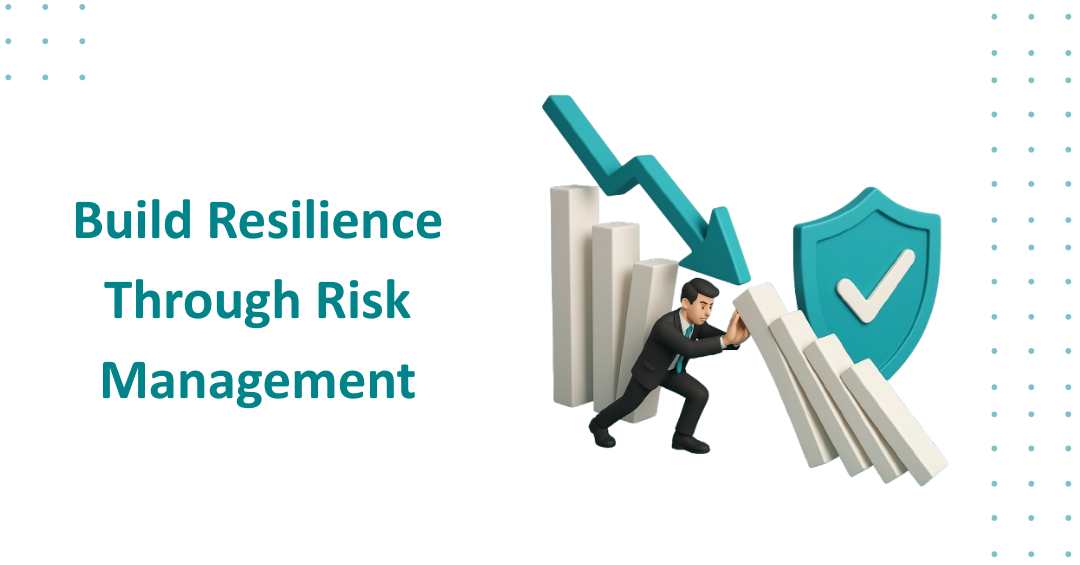
In today's global market, B2B supply chains have arrived at a tipping moment.
In the past, the primary goal was to cut costs and remove waste in the processes. Next, we turn to priorities molded by changes in geoeconomics, sustainability, customer-centricity, and digital disruption. B2B companies need to develop resilience, transparency, and immediacy against a growing array of issues in logistics, compliance, and technology overall.
More than 70% of B2B enterprises are undergoing or planning to plan a major B2B supply chain digital transformation, reports Gartner in 2024. But so what transformation is, and how best can businesses make it happen?
In this blog, we explore the key supply chain strategies for transforming B2B supply chain management and strategy to meet the demands of modern business and align with the future of supply chain innovation.
The Need for Transformation in B2B Supply Chains
Supply chains were once seen as back-office operations. But not anymore.
Today, they are a core business differentiator. Companies with undefineda class="code-link" href="https://www.seaflux.tech/portfolio/blockchain-for-supply-chain-in-dairy-industry" target="_blank"undefinedsmarter enterprise supply chainsundefined/aundefined gain faster go-to-market capability, stronger partner trust, improved customer satisfaction, and better margins.
Here’s why B2B supply chain transformation is critical:
- Disruption is the new normal: No matter if it is pandemics, port stoppages, or cyberattacks, supply chains are subject to endless risk.
- Data overload, insight deficit: Most B2B organizations are collecting tons of data, but have not figured out the pathway to actionable intelligence transformation.
- The juxtaposition of globalization and localization: Companies are donning long global supply lines, and then need to respond to local demand in a much shorter - and likely compressed timeframe.
- The elevation of sustainability regulations: Regulator and investor pressures are causing enterprise supply chains to be eco-responsible.
- Customer expectations are evolving: Every business must give customers real-time status updates, personalization, and transparency of services.
This is where supply chain digital transformation becomes critical, enabling companies to become faster, smarter, and more responsive through technology. The adoption of cloud SCM (cloud supply chain management) and digital supply chain management also plays a crucial role in enabling seamless integration, real-time visibility, and flexible operations at scale. It all forms part of the future of supply chain excellence.
Strategy 1: Achieve End-to-End Supply Chain Visibility
Modern B2B supply chains are complicated; oftentimes, contract manufacturers, warehousing partners, third- and fourth-party logistics interplay.
If you cannot observe the full chain operation in real-time, then how can it be optimized, or how can you secure the chain?
Supply chain visibility is the cornerstone of this transformation. It ensures that businesses can track goods, identify bottlenecks, and make fast, data-driven decisions based on real-time information across the entire value chain.
Methods of Execution:
- Digital twins: Establish a digital metaverse of your supply chain to create a replica of delays, bottlenecks, and disruptions.
- GPS tracking and IoT sensors: Customers can even track their goods and inventory at every stop along the chain-of-custody, from the manufacturer to the transfer of goods at a third-party logistics provider.
- Cloud-hosted dashboards: We can put together logistics, CRM, and ERP data on an integrated dashboard and an easy-access platform.
Example:
DHL employs sensor-driven logistics platforms to provide supply chain visibility of their temperature-sensitive shipments in real-time while giving alerts when thresholds have been breached.
Impact: Lessened delays, improved partner trust, and expectation for real-time corrective action.
Strategy 2: Use AI and Data Analytics to Enhance Decision Making
Enterprise supply chains produce petabytes of data on sales orders, shipments, returns, pricing, payments, and partner performance. But are you using this data proactively?
AI in supply chain allows for more predictive, intelligent, and automated operations across every touchpoint.
Supply chain digital transformation is largely fueled by AI and analytics, providing visibility and control like never before. It’s also a major component of digital supply chain management, where data becomes a real-time strategic asset.
Methods of Execution:
- AI-enabled demand planning: Analyze past sales, cancellations, seasons, and other external trends to make inventory and supply plans.
- Machine Learning algorithms: Identify indicators of change as early warning signals for changes in feeding behavior, transportation risk, etc.
- Prescriptive analytics: Recommend that the best decision is (perhaps rerouting a shipment or considering an alternate supplier).
Example:
By using an AI supply chain management-powered "control tower" model, Unilever was able to increase customer service levels by more than 10% and reduce forecast error by 15%.
Impact: Better ROI, less waste, and more agility.
Strategy 3: Digitize undefined Automate Procurement
Inefficient procurement can lead to missed opportunities, supplier inefficiencies, and excess costs.
Today’s procurement within an enterprise supply chain is data-driven, automated, undefined collaborative with suppliers.
This is a central part of supply chain digital transformation, as digitization reduces friction, accelerates procurement cycles, and enhances data-sharing accuracy. It also directly contributes to the modernization goals of digital supply chain management by enabling frictionless, transparent, and intelligent sourcing.
Methods of Execution:
- E-Procurement systems - Automate the sourcing process, create competitive bidding, and automate the full lifecycle of contract management.
- Supplier self-service portals - Empower vendors to update information, see payment tracking, and track their deliveries without contact.
undefineda class="code-link" href="https://www.seaflux.tech/portfolio/blockchain-to-mint-and-manage-supply-chain" target="_blank"undefinedBlockchainundefined/aundefined- A distributed ledger technology can provide smart contracts, automate execution, and facilitate new triggers for payment and execution that cannot be manipulated. A blockchain in supply chain model also ensures secure, tamper-proof transaction records and traceability across procurement stages.
Example:
Maersk and IBM launched TradeLens, a blockchain-based platform that digitizes shipping documentation, reducing customs delays and fraud.
Impact: Lower admin costs, enhanced supplier trust, and faster purchase cycles.
Strategy 4: Improve Multi-Tier Partner Collaboration
Traditional B2B supply chains are often defined by isolated conversations and communications. But for a supply chain with real dynamism, collaboration is with real partners; i.e., higher-tier partners that have real influence over delivery schedules and product quality.
Establishing supply chain visibility between partners ensures transparency and data-driven collaboration that benefits the entire ecosystem.
Methods of Execution:
- Collaborative plan/planning platforms - allow partners to develop forecasts, inventory approaches, and contingency actions cooperatively.
- Role-sensitive access portals - share relevant partner data across the value chain with safeguards to ensure security and privacy.
- Common KPIs - define partner KPIs in collaboration with the partners to ensure alignment between internal and external teams.
Example:
Procter undefined Gamble shares inventory data in real-time with suppliers, helping them plan production more accurately and reduce excess stock.
Impact: Better service levels, reduced supply risk, and joint accountability.
Strategy 5: Use Cloud-Native SCM Platforms
SCM tools are usually disjointed, rigid, and challenging to join. Cloud-native SCM platforms can be open, scalable, and modular. These platforms are key to executing supply chain digital transformation, enabling organizations to unlock agility and real-time collaboration across global operations.
They also serve as a foundational element of cloud supply chain management, allowing businesses to centralize operations, reduce IT overhead, and accelerate connectivity between systems and stakeholders.
Methods of Execution:
- Move supply chain applications to the cloud: Use platforms such as Coupa, SAP Business Network, and Oracle SCM Cloud.
- Use microservices and Apps: Make it easy to integrate with IoT devices, collaborative partner systems, and outside logistics providers.
- Provide mobile access: Allow teams to have access to dashboards, real-time alerts to manage operations in the field.
Example:
Cisco adopted a cloud-first supply chain management and strategy to manage over 20,000 suppliers globally, resulting in faster onboarding and greater operational resilience.
Impact: Lower IT maintenance, faster innovation cycles, and real-time collaboration.
Strategy 6: Embed Sustainability into the Supply Chain
Sustainability is no longer a checkbox; it’s a strategic priority for governments, investors, customers, and boards alike.
Sustainability is now a driver of supply chain transformation, helping align environmental goals with operational efficiency. As part of a broader digital supply chain management strategy, this ensures that sustainability is not only tracked but also embedded in the decision-making process.
Methods of Execution:
- Tools for tracking carbon: Track emissions by shipment type, region, or vendor.
- Providers of green logistics: Make use of suppliers who provide carbon offsetting, rail transportation instead of air, and electric fleets.
- ESG scoring for suppliers: Assess and prefer suppliers who have solid governance, social, and environmental policies.
Example:
Apple has committed to 100% carbon-neutral supply chains by 2030, engaging suppliers in renewable energy transitions and sustainability audits.
Impact: Brand differentiation, reduced environmental impact, and stronger compliance.
Strategy 7: Build Resilience Through Risk Management
Resilience is the ability to anticipate, adapt to, and recover from disruption, whether it’s a raw material shortage or geopolitical unrest.
Risk management strategies are essential to long-term supply chain transformation, preparing companies to weather unexpected challenges.
Methods of Execution:
- Assessments of supplier risk: Evaluate Tier 1–3 vendors' geopolitical, financial, and compliance risks.
- Techniques for multiple or dual sourcing: Reduce dependence on particular areas or vendors.
- Nearshoring and inventory buffers: Keep safety stock and local production facilities for important SKUs.
Example:
Toyota was one of the first companies to develop a multi-tier supplier risk map, enabling it to recover faster than competitors after the 2011 Japan earthquake.
Impact: Shorter disruption cycles, proactive mitigation, and improved uptime.
Future Trends to Watch
- Hyper-automation: Aggregate AI, RPA, and IoT for a lights-out supply chain
- Composable supply chains: Build-your-own solutions with modular clouds
- AI copilots: Chatbot-style assistant for procurement, shipping, and demand planning
- Sustainable packaging and returns optimization
- Digital trust networks: This refers to using blockchain and AI in the supply chain to source traceably and ethically. The blockchain in supply chain approach here helps build transparency, ensures origin traceability, and boosts trust among all stakeholders.
- The rising prominence of cloud supply chain management as a core driver of scalable and resilient supply chain ecosystems
Final Thoughts
Data will be driving the future of supply chain; Partnering will be the main theme; Resilience will be core. Those companies willing to put in digital capabilities, collaborative ecosystems, and ethical practices that will set them apart today will be the best placed to win tomorrow.
Whether you're just beginning or refining your supply chain strategies for supply chain transformation, now is the time to innovate. As these strategies evolve, companies will need to continuously monitor, adapt, and refine their supply chain management and strategy to remain competitive and compliant.
Ready to Transform Your B2B Supply Chain?
At Seaflux Technologies, we deliver smart, scalable undefineda class="code-link" href="https://www.seaflux.tech/supply-chain-management" target="_blank"undefineddigital supply chain solutionsundefined/aundefined tailored for modern B2B enterprises.
As a trusted blockchain supply chain development company, we offer end-to-end undefineda class="code-link" href="https://www.seaflux.tech/blockchain-development-services" target="_blank"undefinedblockchain development servicesundefined/aundefined and custom blockchain solutions that bring transparency, security, and efficiency to your operations.
Our expert team also provides reliable supply chain software development services from predictive analytics to vendor portals, helping you optimize performance and reduce risk.
Let’s build a more intelligent, resilient supply chain together.
undefineda class="code-link" href="https://calendly.com/seaflux/meeting?month=2025-04" target="_blank"undefinedContact us todayundefined/aundefined to start your digital transformation journey.

Krunal Bhimani
Business Development Executive








